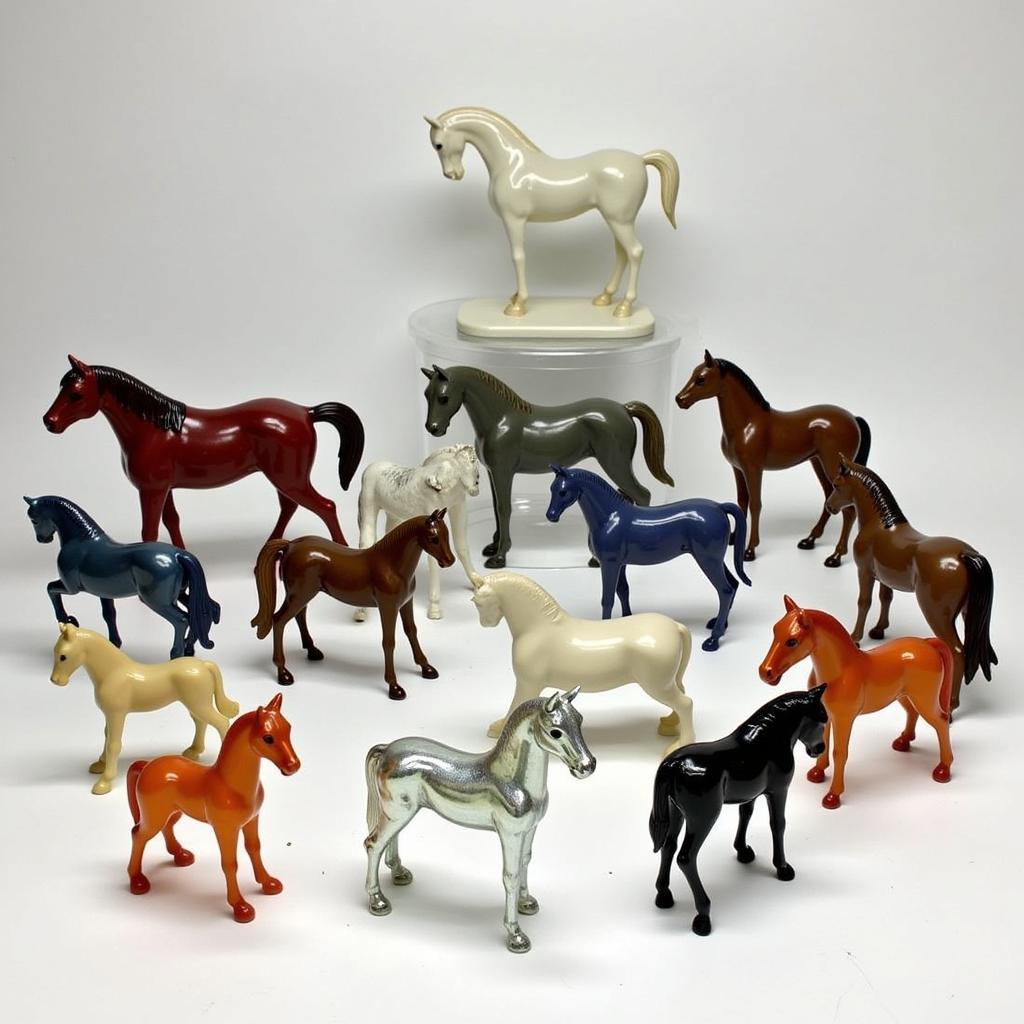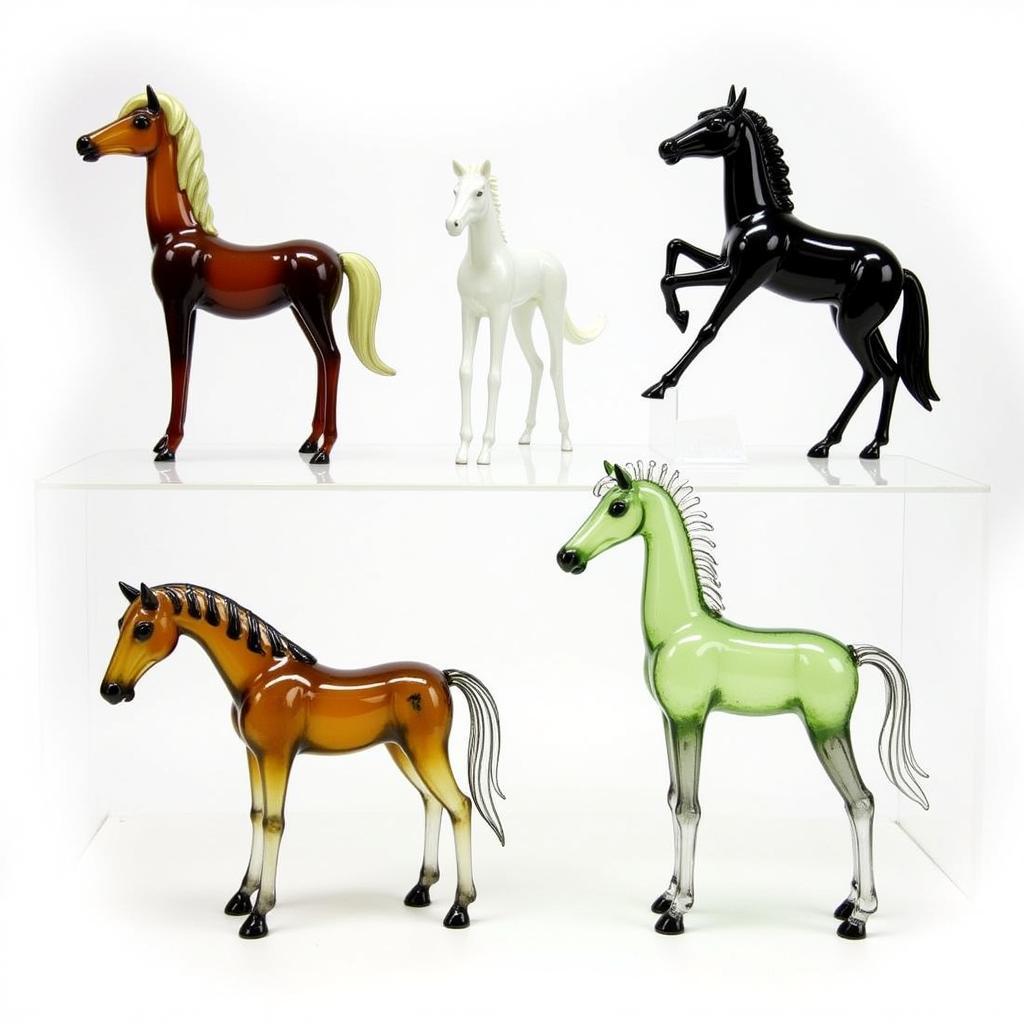Glass Horses, delicate yet powerful symbols of grace and freedom, have captivated collectors and art enthusiasts for generations. Whether it’s a small figurine or a large, intricate sculpture, these shimmering steeds evoke a sense of wonder and timeless beauty. From vintage treasures to modern masterpieces, glass horses represent a unique intersection of art and craftsmanship. This article delves into the captivating world of glass horses, exploring their history, artistry, and enduring appeal. We’ll cover various types, including Murano glass horses, and delve into the nuances of collecting these exquisite pieces.
A History of Glass Horses: From Ancient Crafts to Modern Art
The art of glassmaking dates back millennia, with evidence of glass beads and amulets found in ancient civilizations. While the exact origins of glass horses remain elusive, their presence in various cultures throughout history is undeniable. From ancient Roman glasswork to the exquisite creations of Murano, glass horses have served as both decorative objects and symbolic representations of power, nobility, and freedom. The delicate nature of glass combined with the powerful imagery of the horse creates a compelling juxtaposition that continues to fascinate.
The rise of glassmaking centers like Murano, Italy, in the Renaissance period propelled the artistry of glass to new heights. Murano glassmakers, renowned for their mastery of color and intricate techniques, elevated the glass horse from a simple figurine to a sophisticated work of art. These Murano glass horse sculptures became highly sought-after by collectors and connoisseurs, establishing a legacy that endures to this day.
What makes Murano glass horses so unique?
The intricate details and vibrant colors of Murano glass horses distinguish them from other glass figurines. Skilled artisans employ centuries-old techniques to create these stunning pieces, resulting in works of art that are both beautiful and collectible.
Collecting Glass Horses: A Guide for Enthusiasts
Collecting glass horses can be a rewarding hobby, offering the opportunity to discover unique pieces and learn about the history and artistry of glassmaking. Whether you are drawn to vintage Murano glass horse or contemporary designs, building a collection requires knowledge and discernment.
- Identify your focus: Determine what type of glass horses you are most interested in collecting, such as specific breeds, colors, or makers. For instance, some collectors may specialize in glass horse figurines while others might focus on larger sculptures.
- Research and learn: Study the history of glassmaking, different techniques, and prominent artists. This knowledge will help you identify authentic pieces and appreciate their value.
- Inspect carefully: When examining a glass horse, pay close attention to details like the clarity of the glass, the quality of the workmanship, and any signs of damage or repair.
- Build relationships with reputable dealers: Establishing connections with trusted dealers can provide access to rare and desirable pieces.
 Diverse Glass Horse Collection: Showcasing Variety in Size, Color, and Style
Diverse Glass Horse Collection: Showcasing Variety in Size, Color, and Style
Caring for Your Glass Horses: Preservation and Display
Proper care is essential for preserving the beauty and value of your glass horse collection. Glass is a delicate material, susceptible to scratches, chips, and breakage.
- Handle with care: Always hold glass horses with clean, dry hands to avoid transferring oils or dirt.
- Clean gently: Use a soft, lint-free cloth to dust your glass horses regularly. Avoid using harsh chemicals or abrasive cleaners.
- Display strategically: Choose a stable and secure location for displaying your glass horses, away from direct sunlight and high-traffic areas.
- Store safely: When not on display, wrap each glass horse individually in acid-free tissue paper or bubble wrap and store them in a protective container.
“Protecting your glass horses from dust and accidental damage is crucial for maintaining their value and beauty,” says renowned glass art conservator, Dr. Amelia Glassworth.
Types of Glass Horses: Exploring the Spectrum
The world of glass horses encompasses a wide range of styles, from simple, elegant figurines to complex, multi-colored sculptures. Some notable types include:
- Murano glass horses: Known for their vibrant colors, intricate details, and traditional techniques.
- Art glass horses: Created by individual artists, often featuring unique designs and experimental techniques.
- Pressed glass horses: Mass-produced using molds, resulting in more affordable and widely available pieces.
- Bookends: Functional and decorative, such as the popular Le Smith glass horse bookends.
“The beauty of collecting glass horses lies in the diversity of styles and the opportunity to discover hidden treasures,” notes antique glass expert, Mr. Harold Antique. “From the classic elegance of a Heisey glass horse to the modern flair of a contemporary artist’s creation, there’s a glass horse for every taste.”
 Modern Glass Horse Sculptures: Exploring Contemporary Artistic Expression in Glass
Modern Glass Horse Sculptures: Exploring Contemporary Artistic Expression in Glass
Conclusion
Glass horses, in all their shimmering beauty, represent a timeless art form that continues to capture the imagination. Whether you are a seasoned collector or simply admire the artistry of glass, these elegant figures offer a unique blend of beauty, craftsmanship, and symbolism. From vintage Murano treasures to contemporary masterpieces, glass horses are a testament to the enduring power of art to inspire and delight.
FAQ
- What are Murano glass horses? Murano glass horses are handcrafted in Murano, Italy, known for their vibrant colors and intricate details.
- How do I clean a glass horse? Clean your glass horse gently with a soft, lint-free cloth.
- Where can I buy glass horses? You can find glass horses at antique shops, art galleries, and online marketplaces.
- Are glass horses valuable? The value of a glass horse depends on factors like its age, maker, and condition.
- How should I store my glass horses? Wrap them individually in acid-free tissue paper and store them in a protective container.
- What are some popular types of glass horses? Murano, Art glass, Pressed glass, and bookends.
- How do I identify a valuable glass horse? Research makers, look for unique features and consult with experts.
Other questions you might have
- How to display glass horses?
- How to repair chipped glass horses?
- Where to find antique glass horse appraisals?
For further information on caring for and collecting glass horses, explore other articles on our website.
Need assistance? Contact us 24/7:
Phone: 0772127271
Email: [email protected]
Address: QGM2+WX2, Vị Trung, Vị Thuỷ, Hậu Giang, Việt Nam.